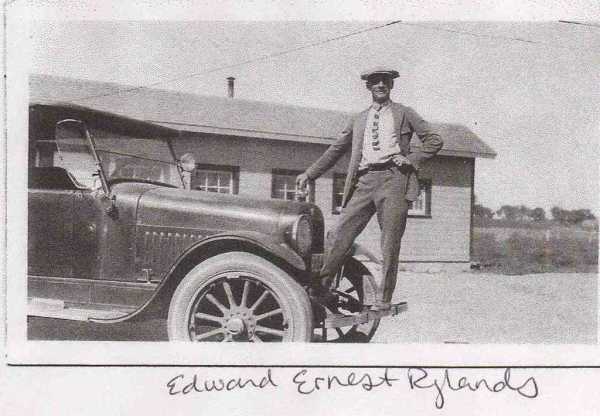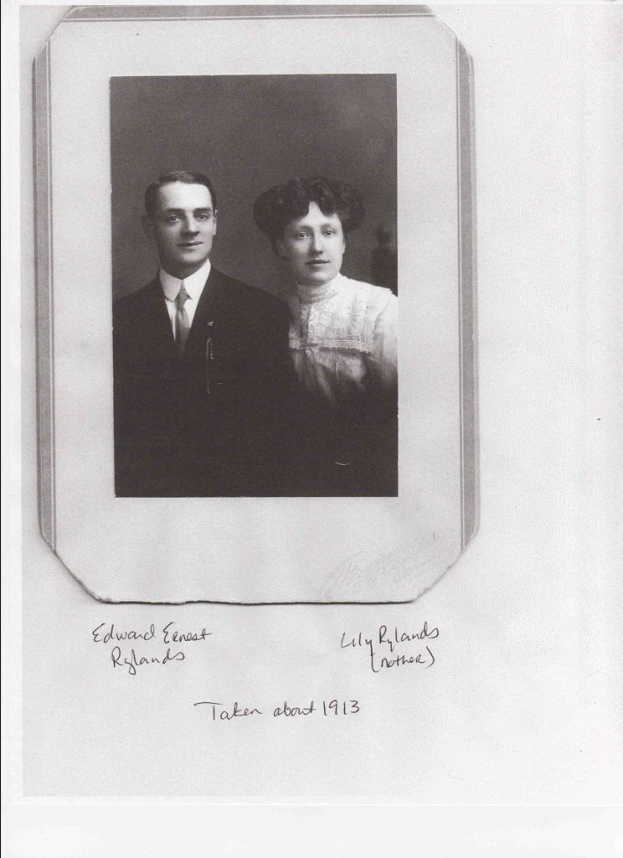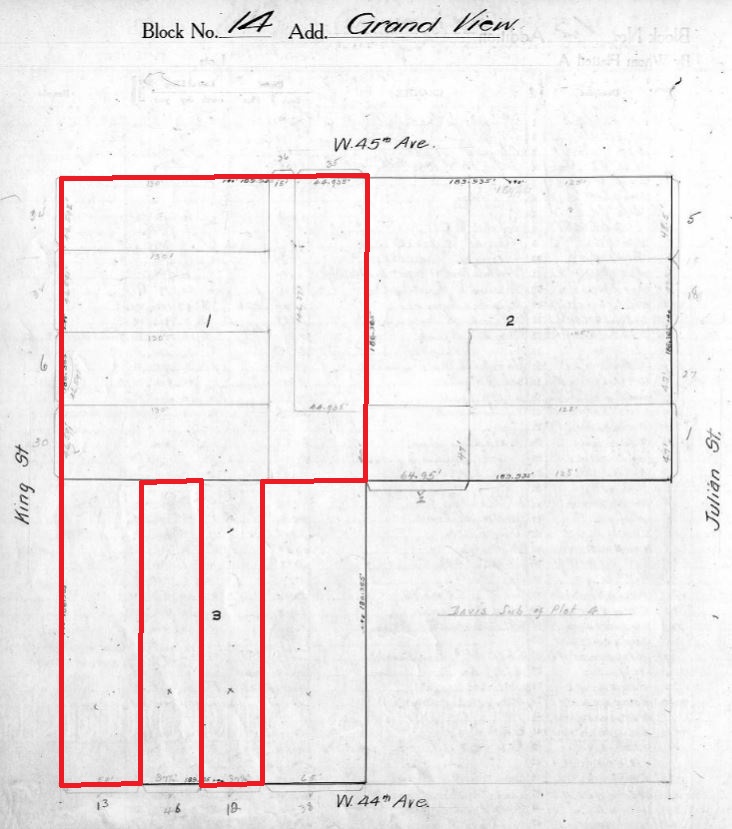By Guest Blogger Paul Cloyd
In November 1973 Denver City Council designated the house at 3520 Newton Street a Denver Landmark, a structure to be preserved as the “John Brisben Walker House.” The landmark application stated the Newton Street house: “…. was reported to have been the home of Denver pioneer planner and conservationist John Brisben Walker. He resided at that address from 1890 to 1901. The house was built of Castle Rock Lava stone in 1885….” The application cited the source of historical information as “HABS” [ Historic American Building Survey] form.” No other information source was listed.
Less than 18 months later, in March 1975, Ruth Wiberg, the well-regarded North Denver historian, wrote to John Brisben’s granddaughter, Mrs. Pierpont Fuller (Frances Strother Walker Fuller) about the house’s history. Wiberg’s letter indicated that information she had recently received led her to question who originally owned and resided in the house. Her 1975 letter[1] included the following points:
- An 1885 map of Denver[2] indicated the property was owned, not by John Brisben Walker (JBW) but rather by his brother Bolivar Krebbs Walker.
- The same 1885 map showed an elaborate estate located on 38th Avenue between Wolff St and Winona Court [basically across from what today is Sprouts] and identified this as the residence of John B Walker.
- City directories of 1886 and for the following few years listed Bolivar K. Walker as residing at the property 3520 Newton address while showing JBW resided at a Berkeley Farm residence.
- Wiberg suggested that the official notice to the [Landmark] commission [on this new information] should be deferred “… until we have definitive information on [who] the original owner was, but I am sending a carbon copy of this letter to David Wicks.” [3]

In her 1976 book, Rediscovering Northwest Denver, Wiberg suggested definitive information on the original owner remained elusive, noting “… he [ JBW] was either the owner of the large stone house at 3520 Newton Street or the lender of the money which built it”[4] In the book she stated that “in city directories for many years it is Bolivar who is listed as a resident at the house which became numbered at 3520 Newton…. Originally the house was reached by a long sweeping two block long drive from West 35th and Lowell…The property held beautiful gardens, a private reservoir and a large stable for Mr. Walker’s polo ponies”
Ownership and Residences of the Walker Brothers
Bolivar K. Walker at 3520 Newton Street
A deed dated April 1, 1881 shows Sam S. Landon conveyed the original 10-acre property that would hold the Newton Street house to Bolivar K. Walker for $1,000.[5] The parcel described in this deed coincides with the parcel the 1885 Rollandet map indicates as belonging to “BK Walker”. Using today’s street names, the property was bounded by; Lowell Blvd on the east, 35th Avenue on the south, Newton Street on the west and West 37th Avenue on the north. In November 1883 Bolivar had sold the property to his brother, John Brisben.[6] The 1883 deed appears to reflect that John Brisben obtained the property by paying off a $2,000 mortgage on the property that Bolivar owed. A July 1884 newspaper[7] notice states: “Mr. Walker’s new stone residence on the hill is about complete. Mr. Walker has the most sightly location in the town of Highlands.” Edward Rollandet’s September 1885 map of Denver erroneously shows Bolivar as owner of the parcel he had sold a year–and-a-half earlier. The elaborate John Brisbane Walker residence on West 38th Avenue (Prospect Avenue) is identified on the map, as well. In February 1888 the Highland Park Company acquired the 10-acre parcel that includes the Newton property from John Brisben Walker for $19,500.[8] City directories from 1882 through 1887 list John Brisben Walker as the general manager for the Highland Park Company, a real estate enterprise, but he is no longer listed in that position after 1887.
Denver city directories for 1886 through 1891 indicate Bolivar was living on the Newton Street property. The 1892 and 1893 directories record that Bolivar moved elsewhere in Denver for two years, but in 1894 he was back at the house and remained there until 1899. By 1900 Bolivar relocated his family to 1034 South 14th Street[9]. He does not appear ever to have returned to live at 3520 Newton Street.
John Brisben Walker on the Berkeley Farm (near West 38th Avenue and Winona Street)
Denver city directories from 1881 through 1888 list John Brisben Walker residing at Berkeley Farm. However, a New York City directory records that, as of 1889, he had relocated: his workplace to New York City and resided in Irvington, New York. Later New York City directories and the 1900 US Census document that John Brisben Walker remained in New York for several more years. To date, no information has been located to suggest he ever lived at 3520 Newton Street or that he purchased it back after selling the property in 1888. A 1907 newspaper article indicates that “the old John Brisben Walker homestead at West Thirty-eight avenue and Winona court, was sold yesterday….” John Brisben Walker died in Brooklyn, New York, on July 7, 1931. Though his New York Times obituary mentions ‘… he is survived by…. a sister living in Denver…” his brother Bolivar (who lived until July 1941) is not mentioned.
Addresses and Map Documentation for Newton Street Property
In May 1888 the Highland Park Company subdivided the Newton Street parcel into three blocks and named it “Cumberland Subdivision,” as seen in the 1905 Baist map. The property address went through multiple iterations. At the time of Bolivar’s 1881 purchase, it was described through what surveyors call “aliquot parts”, i.e. the southeast quarter of the northeast quarter of the north east quarter of section 30, Township 3 South, Range 68 West. In the years following the construction and occupancy of the house in 1885, the address appeared in city directories as Lake av, cor Cumberland, Highlands in 1889 or Scott ne cor 15th Highlands in 1894. Lake av was an old name (one of a few) for Lowell Boulevard., with Scott and Cumberland being old names for West 35th Avenue. Fifteenth street was one of multiple old names for what is now Newton Street. However, Newton was interrupted at West 35th and 36th avenues for many years until the street right of way was obtained by the city in the 1926[10] The 1905 Baist map shows the neighbor to west at the time, Mr. F.C. Farnsworth, had a nice brick house situated in what would become the middle of Newton Street.

By the time of the 1888 subdivision, the house’s surrounding landscape became much reduced. The property then fronted onto Meade Street and its street address is 3525 Meade Street.[11] In late 1920s and early 1930s the surrounding land was further subdivided into the lots we see today.[12] This resulted in the loss of access frontage to Meade Street. Newton Street was extended through the 3500 block, and the house’s street address finally became 3520 Newton Street.
The house had several owners through the 20th century. Of note is Grace T. Pollice, who acquired the house in 1946 and was the owner in 1973, at the time of Landmark designation. She retained ownership until the year 2000, a tenure of 54 years. [13]
[1] Denver City Directory, 1899, entry for Bolivar Walker.
[2] Jones Subdivision plat, 1931 Denver map E24-029.
[3] Denver Recorder and Clerk’s Office, reception numbers 0000183795 and 1946268869.
[4] Ruth Wiberg, Rediscovering Northwest Denver, (Denver: Northwest Denver Books, 1976) 113.
[5] Warranty deed, Reception number 1881906787, Denver Recorder and Clerk’s Office.
[6] Warranty deed, Reception number 1884901496, Denver Recorder and Clerk’s Office.
[7] Denver Republic July 1884
[8] Warranty deed, Reception number 1888912028, Denver Recorder and Clerk’s Office
[9] 1900 US Census
[10] 1908 official city survey with annotations up to the 1920s, Denver Map E08_086.
[11] The 1975 letter and 1973 landmark application are together in the Landmark Preservation Commission archives file for the John Brisben house, Denver Public Library.
[12] Denver map, September 1885, Edward Rollandet, publisher, Denver.
[13] David Wicks was a planner with the city of Denver, presumably associated with the Landmark Preservation office. Polk´s Denver City Directory, 1979, 1067; Ancestry.com; U.S., City Directories, 1822-1995.





